Analyzing Management Accounting Systems: Tools and Techniques
VerifiedAdded on 2020/10/04
|20
|5966
|49
Essay
AI Summary
Management accounting plays a pivotal role in providing financial information that aids management decision-making. This essay explores the intricate components of Management Accounting Systems by examining essential tools such as Inventory Management, Job-Costing, Price-Optimization, and Cost Accounting. Each tool serves distinct functions; for instance, Inventory Management ensures optimal stock levels to prevent overstocking or stockouts. Meanwhile, Job-Costing provides detailed cost insights into specific projects or jobs, facilitating more accurate pricing and profitability analysis. Additionally, the essay discusses Price-Optimization techniques that help businesses set competitive prices while maximizing profits. Cost Accounting is highlighted as a crucial aspect for tracking expenses and managing budgets efficiently. Furthermore, various budgetary control methods such as financial and operating budgets are reviewed to understand their roles in planning and controlling organizational resources. Non-monetary budgets and the differentiation between fixed and variable budgets are also discussed to provide a holistic view of budgeting practices within management accounting. The essay concludes by emphasizing how these tools collectively support strategic decision-making, thereby enhancing overall business performance.

MANAGEMENT
ACCOUNTING
ACCOUNTING
Paraphrase This Document
Need a fresh take? Get an instant paraphrase of this document with our AI Paraphraser
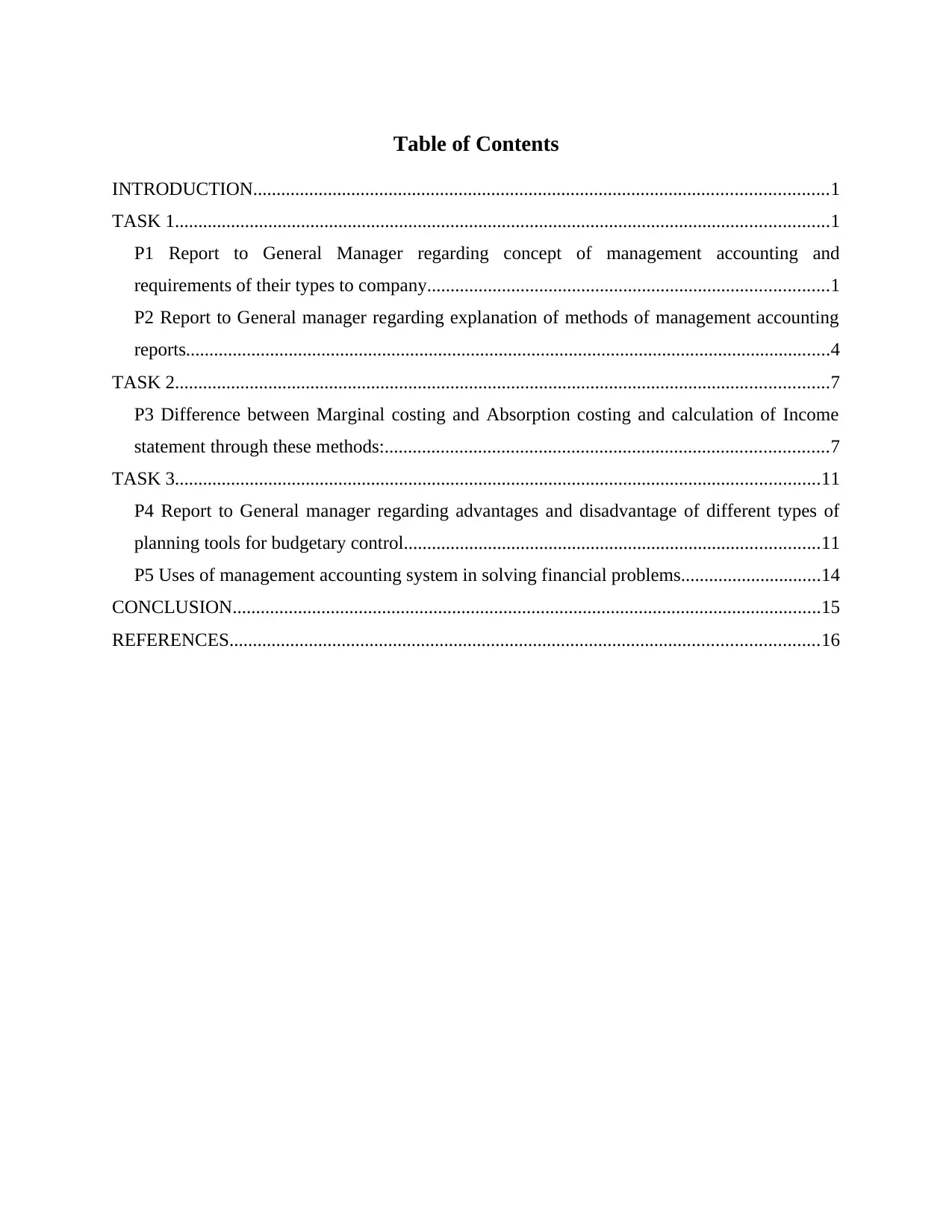
Table of Contents
INTRODUCTION...........................................................................................................................1
TASK 1............................................................................................................................................1
P1 Report to General Manager regarding concept of management accounting and
requirements of their types to company......................................................................................1
P2 Report to General manager regarding explanation of methods of management accounting
reports..........................................................................................................................................4
TASK 2............................................................................................................................................7
P3 Difference between Marginal costing and Absorption costing and calculation of Income
statement through these methods:...............................................................................................7
TASK 3..........................................................................................................................................11
P4 Report to General manager regarding advantages and disadvantage of different types of
planning tools for budgetary control.........................................................................................11
P5 Uses of management accounting system in solving financial problems..............................14
CONCLUSION..............................................................................................................................15
REFERENCES..............................................................................................................................16
INTRODUCTION...........................................................................................................................1
TASK 1............................................................................................................................................1
P1 Report to General Manager regarding concept of management accounting and
requirements of their types to company......................................................................................1
P2 Report to General manager regarding explanation of methods of management accounting
reports..........................................................................................................................................4
TASK 2............................................................................................................................................7
P3 Difference between Marginal costing and Absorption costing and calculation of Income
statement through these methods:...............................................................................................7
TASK 3..........................................................................................................................................11
P4 Report to General manager regarding advantages and disadvantage of different types of
planning tools for budgetary control.........................................................................................11
P5 Uses of management accounting system in solving financial problems..............................14
CONCLUSION..............................................................................................................................15
REFERENCES..............................................................................................................................16

⊘ This is a preview!⊘
Do you want full access?
Subscribe today to unlock all pages.

Trusted by 1+ million students worldwide
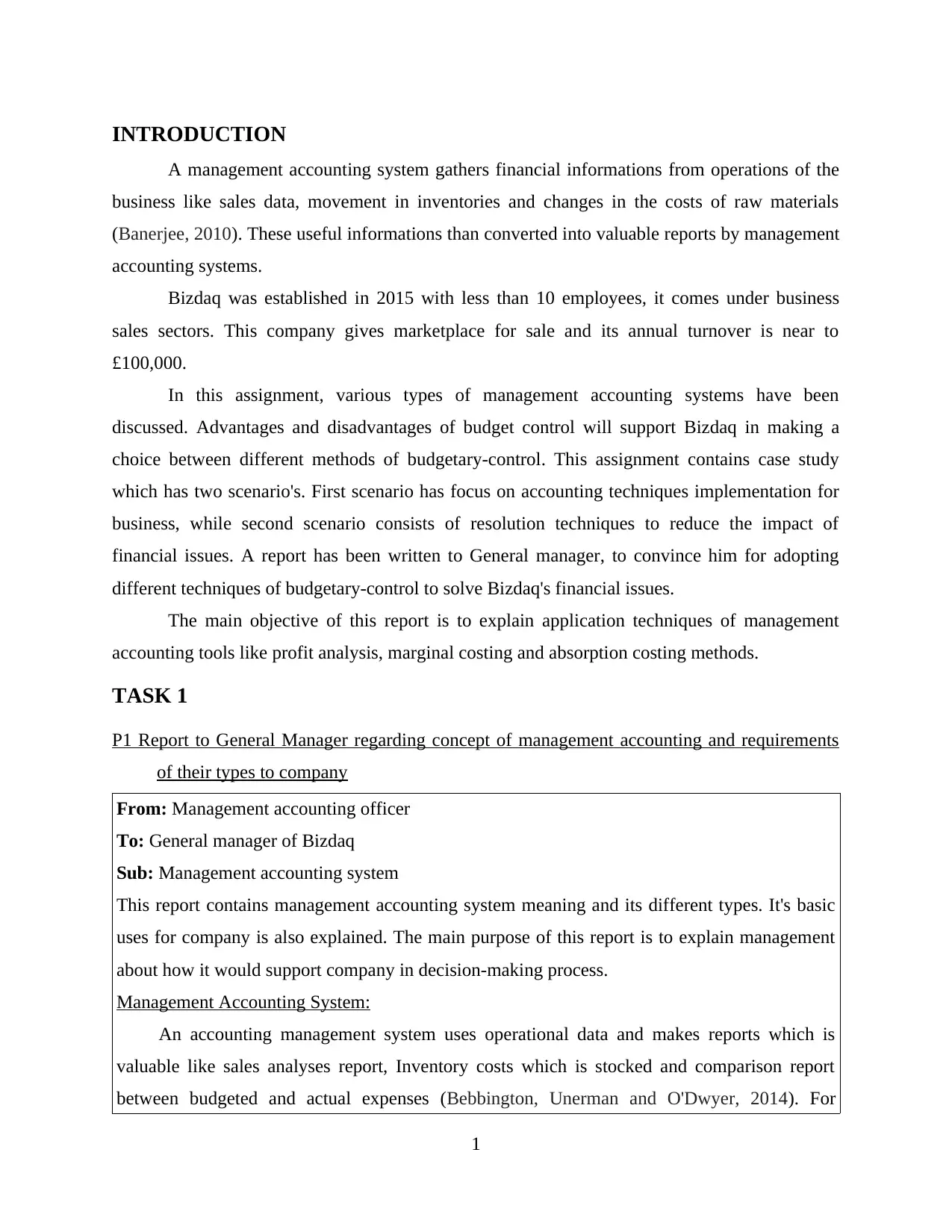
INTRODUCTION
A management accounting system gathers financial informations from operations of the
business like sales data, movement in inventories and changes in the costs of raw materials
(Banerjee, 2010). These useful informations than converted into valuable reports by management
accounting systems.
Bizdaq was established in 2015 with less than 10 employees, it comes under business
sales sectors. This company gives marketplace for sale and its annual turnover is near to
£100,000.
In this assignment, various types of management accounting systems have been
discussed. Advantages and disadvantages of budget control will support Bizdaq in making a
choice between different methods of budgetary-control. This assignment contains case study
which has two scenario's. First scenario has focus on accounting techniques implementation for
business, while second scenario consists of resolution techniques to reduce the impact of
financial issues. A report has been written to General manager, to convince him for adopting
different techniques of budgetary-control to solve Bizdaq's financial issues.
The main objective of this report is to explain application techniques of management
accounting tools like profit analysis, marginal costing and absorption costing methods.
TASK 1
P1 Report to General Manager regarding concept of management accounting and requirements
of their types to company
From: Management accounting officer
To: General manager of Bizdaq
Sub: Management accounting system
This report contains management accounting system meaning and its different types. It's basic
uses for company is also explained. The main purpose of this report is to explain management
about how it would support company in decision-making process.
Management Accounting System:
An accounting management system uses operational data and makes reports which is
valuable like sales analyses report, Inventory costs which is stocked and comparison report
between budgeted and actual expenses (Bebbington, Unerman and O'Dwyer, 2014). For
1
A management accounting system gathers financial informations from operations of the
business like sales data, movement in inventories and changes in the costs of raw materials
(Banerjee, 2010). These useful informations than converted into valuable reports by management
accounting systems.
Bizdaq was established in 2015 with less than 10 employees, it comes under business
sales sectors. This company gives marketplace for sale and its annual turnover is near to
£100,000.
In this assignment, various types of management accounting systems have been
discussed. Advantages and disadvantages of budget control will support Bizdaq in making a
choice between different methods of budgetary-control. This assignment contains case study
which has two scenario's. First scenario has focus on accounting techniques implementation for
business, while second scenario consists of resolution techniques to reduce the impact of
financial issues. A report has been written to General manager, to convince him for adopting
different techniques of budgetary-control to solve Bizdaq's financial issues.
The main objective of this report is to explain application techniques of management
accounting tools like profit analysis, marginal costing and absorption costing methods.
TASK 1
P1 Report to General Manager regarding concept of management accounting and requirements
of their types to company
From: Management accounting officer
To: General manager of Bizdaq
Sub: Management accounting system
This report contains management accounting system meaning and its different types. It's basic
uses for company is also explained. The main purpose of this report is to explain management
about how it would support company in decision-making process.
Management Accounting System:
An accounting management system uses operational data and makes reports which is
valuable like sales analyses report, Inventory costs which is stocked and comparison report
between budgeted and actual expenses (Bebbington, Unerman and O'Dwyer, 2014). For
1
Paraphrase This Document
Need a fresh take? Get an instant paraphrase of this document with our AI Paraphraser
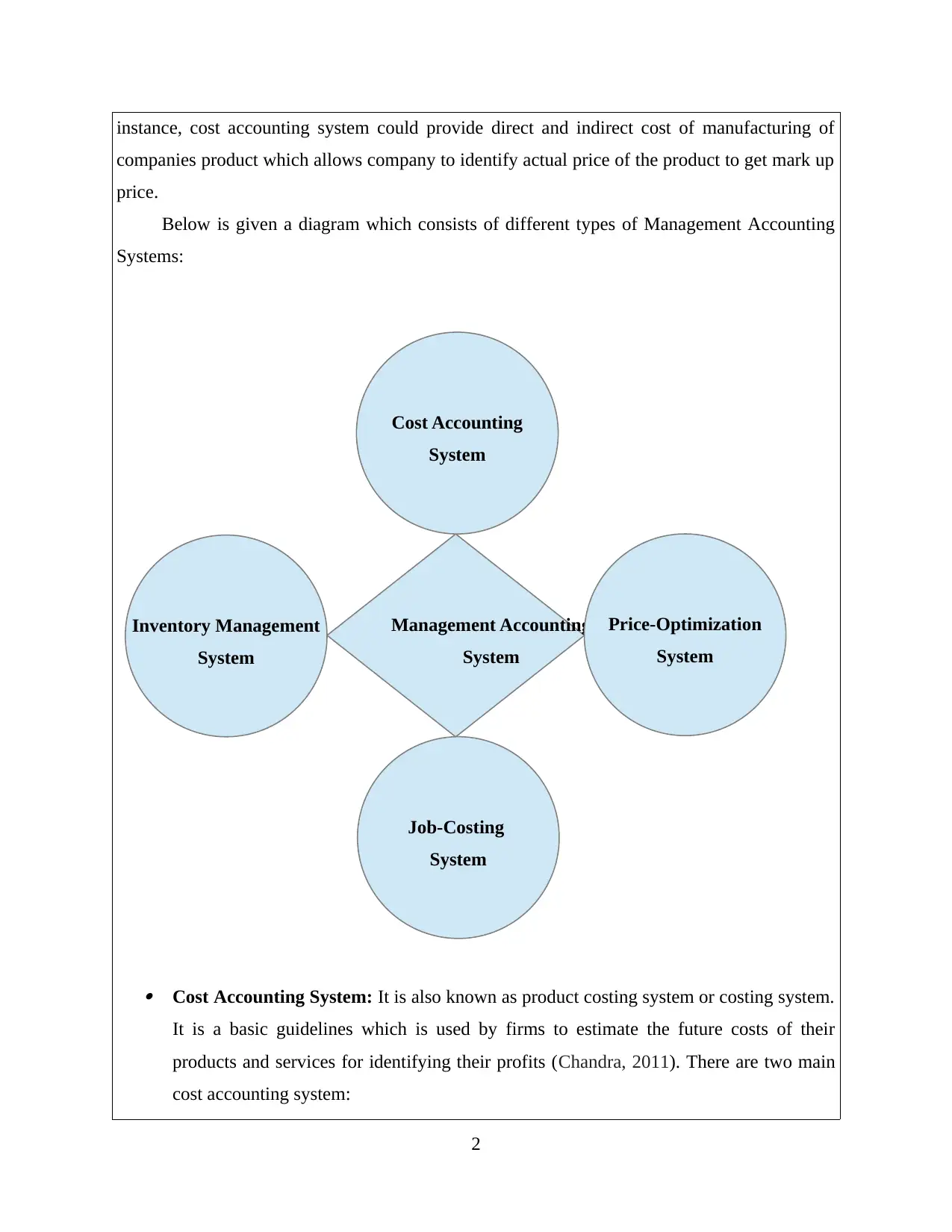
instance, cost accounting system could provide direct and indirect cost of manufacturing of
companies product which allows company to identify actual price of the product to get mark up
price.
Below is given a diagram which consists of different types of Management Accounting
Systems:
Cost Accounting System: It is also known as product costing system or costing system.
It is a basic guidelines which is used by firms to estimate the future costs of their
products and services for identifying their profits (Chandra, 2011). There are two main
cost accounting system:
2
Management Accounting
System
Inventory Management
System
Job-Costing
System
Price-Optimization
System
Cost Accounting
System
companies product which allows company to identify actual price of the product to get mark up
price.
Below is given a diagram which consists of different types of Management Accounting
Systems:
Cost Accounting System: It is also known as product costing system or costing system.
It is a basic guidelines which is used by firms to estimate the future costs of their
products and services for identifying their profits (Chandra, 2011). There are two main
cost accounting system:
2
Management Accounting
System
Inventory Management
System
Job-Costing
System
Price-Optimization
System
Cost Accounting
System
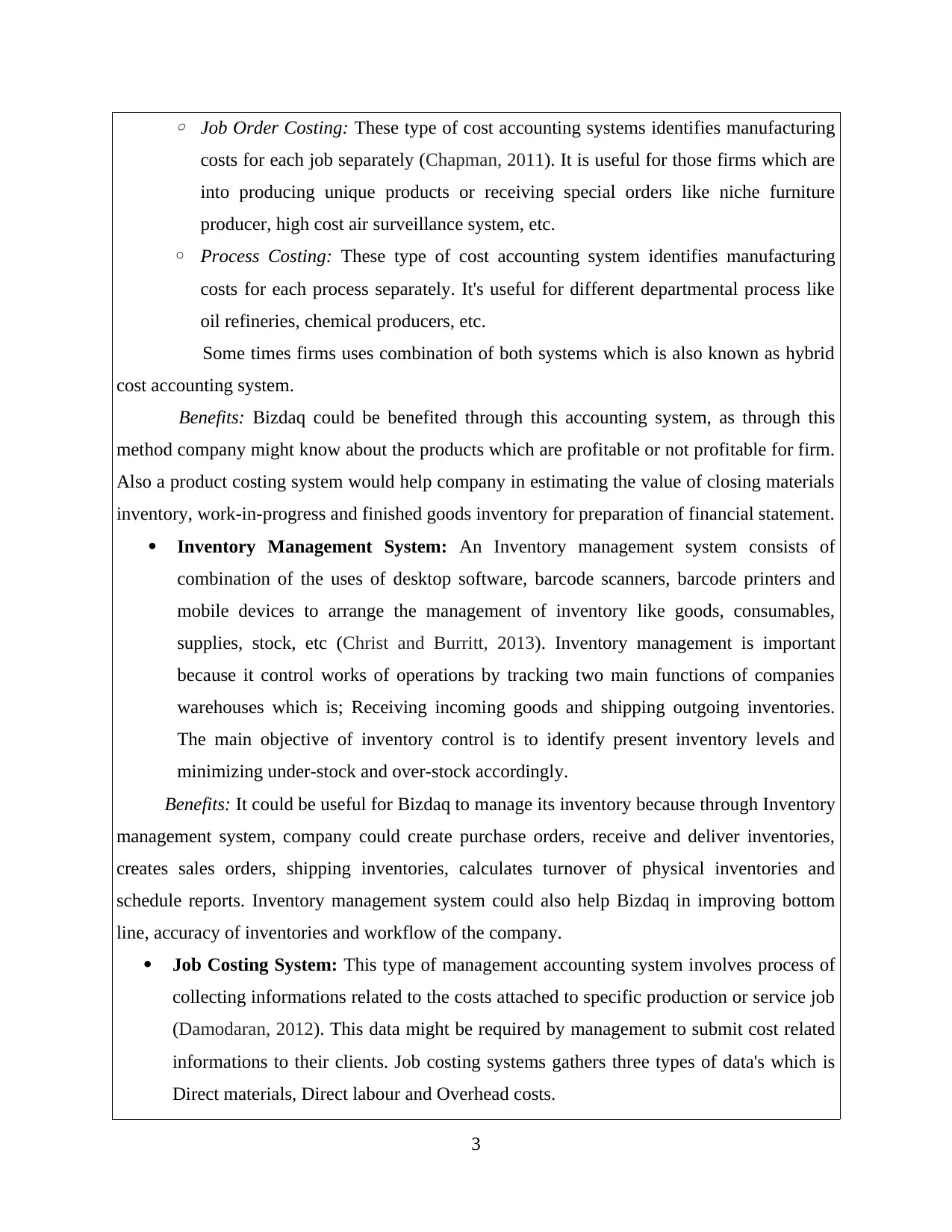
◦ Job Order Costing: These type of cost accounting systems identifies manufacturing
costs for each job separately (Chapman, 2011). It is useful for those firms which are
into producing unique products or receiving special orders like niche furniture
producer, high cost air surveillance system, etc.
◦ Process Costing: These type of cost accounting system identifies manufacturing
costs for each process separately. It's useful for different departmental process like
oil refineries, chemical producers, etc.
Some times firms uses combination of both systems which is also known as hybrid
cost accounting system.
Benefits: Bizdaq could be benefited through this accounting system, as through this
method company might know about the products which are profitable or not profitable for firm.
Also a product costing system would help company in estimating the value of closing materials
inventory, work-in-progress and finished goods inventory for preparation of financial statement.
Inventory Management System: An Inventory management system consists of
combination of the uses of desktop software, barcode scanners, barcode printers and
mobile devices to arrange the management of inventory like goods, consumables,
supplies, stock, etc (Christ and Burritt, 2013). Inventory management is important
because it control works of operations by tracking two main functions of companies
warehouses which is; Receiving incoming goods and shipping outgoing inventories.
The main objective of inventory control is to identify present inventory levels and
minimizing under-stock and over-stock accordingly.
Benefits: It could be useful for Bizdaq to manage its inventory because through Inventory
management system, company could create purchase orders, receive and deliver inventories,
creates sales orders, shipping inventories, calculates turnover of physical inventories and
schedule reports. Inventory management system could also help Bizdaq in improving bottom
line, accuracy of inventories and workflow of the company.
Job Costing System: This type of management accounting system involves process of
collecting informations related to the costs attached to specific production or service job
(Damodaran, 2012). This data might be required by management to submit cost related
informations to their clients. Job costing systems gathers three types of data's which is
Direct materials, Direct labour and Overhead costs.
3
costs for each job separately (Chapman, 2011). It is useful for those firms which are
into producing unique products or receiving special orders like niche furniture
producer, high cost air surveillance system, etc.
◦ Process Costing: These type of cost accounting system identifies manufacturing
costs for each process separately. It's useful for different departmental process like
oil refineries, chemical producers, etc.
Some times firms uses combination of both systems which is also known as hybrid
cost accounting system.
Benefits: Bizdaq could be benefited through this accounting system, as through this
method company might know about the products which are profitable or not profitable for firm.
Also a product costing system would help company in estimating the value of closing materials
inventory, work-in-progress and finished goods inventory for preparation of financial statement.
Inventory Management System: An Inventory management system consists of
combination of the uses of desktop software, barcode scanners, barcode printers and
mobile devices to arrange the management of inventory like goods, consumables,
supplies, stock, etc (Christ and Burritt, 2013). Inventory management is important
because it control works of operations by tracking two main functions of companies
warehouses which is; Receiving incoming goods and shipping outgoing inventories.
The main objective of inventory control is to identify present inventory levels and
minimizing under-stock and over-stock accordingly.
Benefits: It could be useful for Bizdaq to manage its inventory because through Inventory
management system, company could create purchase orders, receive and deliver inventories,
creates sales orders, shipping inventories, calculates turnover of physical inventories and
schedule reports. Inventory management system could also help Bizdaq in improving bottom
line, accuracy of inventories and workflow of the company.
Job Costing System: This type of management accounting system involves process of
collecting informations related to the costs attached to specific production or service job
(Damodaran, 2012). This data might be required by management to submit cost related
informations to their clients. Job costing systems gathers three types of data's which is
Direct materials, Direct labour and Overhead costs.
3
⊘ This is a preview!⊘
Do you want full access?
Subscribe today to unlock all pages.

Trusted by 1+ million students worldwide

Benefits: It is useful for Bizdaq because it could help company in modify informations
according to the requirements of customer. As clients only allows to charge certain costs to their
jobs.
Price-Optimization System: These systems are mathematical programs which
calculates variance of demands at different level of prices and combines the data
information on costs and inventory levels to suggests prices for earning profits (David,
2011). Price-Optimization system works on three critical pricing elements like price
strategy of a company, value of product for buyer and sellers and strategies of
management to control profitability elements.
Benefits: It would help Bizdaq in determining starting prices, promotion pricing and
discount pricing.
P2 Report to General manager regarding explanation of methods of management accounting
reports
From: Management accounting officer
To: General manager of Bizdaq
Sub: Management accounting report
The objective of this report is to explain different methods of reporting in accounting
management process and to describe the possible applications of these reports to support
company for appropriate decision-making process.
Management Accounting Report
These management accounting reports supports business in determining performance of
the company. It is usually created at the end of every year and used by top management to know
financial status of the company in a market (Eastman, 2012). It gives guidelines to a manager to
modify some process to increase or improve performance of a company.
Management accounting report is also important because it supports company in
estimating future costs in advance, it helps in making budgets, make or buy decisions, reacts
against variances in financial performance of a company. It determines which factors is not
performing well. For instance variable costing and marginal costing methods identifies per unit
cost of machineries, labour, materials and variable overheads to know exact production costs of
4
according to the requirements of customer. As clients only allows to charge certain costs to their
jobs.
Price-Optimization System: These systems are mathematical programs which
calculates variance of demands at different level of prices and combines the data
information on costs and inventory levels to suggests prices for earning profits (David,
2011). Price-Optimization system works on three critical pricing elements like price
strategy of a company, value of product for buyer and sellers and strategies of
management to control profitability elements.
Benefits: It would help Bizdaq in determining starting prices, promotion pricing and
discount pricing.
P2 Report to General manager regarding explanation of methods of management accounting
reports
From: Management accounting officer
To: General manager of Bizdaq
Sub: Management accounting report
The objective of this report is to explain different methods of reporting in accounting
management process and to describe the possible applications of these reports to support
company for appropriate decision-making process.
Management Accounting Report
These management accounting reports supports business in determining performance of
the company. It is usually created at the end of every year and used by top management to know
financial status of the company in a market (Eastman, 2012). It gives guidelines to a manager to
modify some process to increase or improve performance of a company.
Management accounting report is also important because it supports company in
estimating future costs in advance, it helps in making budgets, make or buy decisions, reacts
against variances in financial performance of a company. It determines which factors is not
performing well. For instance variable costing and marginal costing methods identifies per unit
cost of machineries, labour, materials and variable overheads to know exact production costs of
4
Paraphrase This Document
Need a fresh take? Get an instant paraphrase of this document with our AI Paraphraser

a product.
Below is the diagram of different types of Management Accounting Reports methods:
Accounts Receivable Aging Report: Accountable aging is a periodic report that
periodically receives a company's account, which is an invoice outstanding. It is used as
a gauge for determining the financial position of the customers of the company (Goetsch
and Davis, 2014). If the account receives a qualified age, indicating that the receipts of a
company are being collected more slowly than usual, it is a warning sign that the
business may be slow or the company is more vulnerable to its sales practices.
This method could be applied by Bizdaq to identify the tenure taken by buyers of a
company to pay back its amount. Like for example, company might control its debtors through
analysing debts given to them in previous year. As increase in trade debtors would affect
efficiency of companies cash flows. Therefore Accounts receivable aging report might support
Bizdaq in controlling excess distribution of cash among buyers.
Job Costs Reports: These reports lists down all types of job costs which are incurred
for each job or project. It is subtotalled by vendors. To support the cost of a job for an
accounting system, it should be assigned job numbers and different items of revenue
(Granlund, 2011). A job can be defined as a specific project for a client, or a unit of
5
Methods of Management Accounting Report
Accounts receivable
Aging Report
Job costs Reports
Income statement
report
Cash flow reportBudget Report
Inventory reports
Below is the diagram of different types of Management Accounting Reports methods:
Accounts Receivable Aging Report: Accountable aging is a periodic report that
periodically receives a company's account, which is an invoice outstanding. It is used as
a gauge for determining the financial position of the customers of the company (Goetsch
and Davis, 2014). If the account receives a qualified age, indicating that the receipts of a
company are being collected more slowly than usual, it is a warning sign that the
business may be slow or the company is more vulnerable to its sales practices.
This method could be applied by Bizdaq to identify the tenure taken by buyers of a
company to pay back its amount. Like for example, company might control its debtors through
analysing debts given to them in previous year. As increase in trade debtors would affect
efficiency of companies cash flows. Therefore Accounts receivable aging report might support
Bizdaq in controlling excess distribution of cash among buyers.
Job Costs Reports: These reports lists down all types of job costs which are incurred
for each job or project. It is subtotalled by vendors. To support the cost of a job for an
accounting system, it should be assigned job numbers and different items of revenue
(Granlund, 2011). A job can be defined as a specific project for a client, or a unit of
5
Methods of Management Accounting Report
Accounts receivable
Aging Report
Job costs Reports
Income statement
report
Cash flow reportBudget Report
Inventory reports

manufactured product or a batch of units of the same type, which are produced
simultaneously.
The application of Job Costing Reports might support Bizdaq in identifying those
activities which are consumed lots of cash. Through this reporting method company could
modify informations according to the requirements of customer. As clients only allows to
charge certain costs to their jobs.
Budget Reports: To support the cost of the job for the accounting system, it should be
assigned the number of jobs and different items of revenue. A job can be defined as a
specific project for the customer, or a batch of units of the same product or the same
type of units which are produced simultaneously (Kimmel, Weygandt and Kieso, 2010).
According to the report of this budget, the estimate should be based on the previous
trends of actual expenditure, revenue and prices. This organization also helps in the
distribution of incentives among its employees. Budget reports are generally limited to
the reporter's strong analytical and assessment skills. Financial status, income and
expenditure data can be modified on a regular basis by a company. Financial data is
usually recorded in the budget report, which is also known as the financial report, it has
been written and written based on the requirements of a company.
Application: Through application of budget reports, Bizdaq would get a support in
analysing the variances between budgeted and actual costs. As more deviation reflects
inefficiency of a company to manage demands and supply of a product, while less variances
indicates that Bizdaq is very well utilising its resources and successfully eliminating the extra
wastes.
Cash Flow Statement Report: In management accounting reports, this types is also
known as statement of cash flows. Cash flow statement is a financial statement which
tracks the changes of balance sheet and Profit&loss accounts (Linoff and Berry, 2011).
It determines how much cash is inflows and outflows from operating, investment and
financial activities.
Application: Bizdaq could apply this reporting method, in order to obtain the liquidity of
its business through analysis of cash flow statement reports, for example, the net profit of the
company is £9300 according to the direct cost, which has been earned which means that it is
actually in exchange for cash Not earned by business. Therefore, the realization of how much
6
simultaneously.
The application of Job Costing Reports might support Bizdaq in identifying those
activities which are consumed lots of cash. Through this reporting method company could
modify informations according to the requirements of customer. As clients only allows to
charge certain costs to their jobs.
Budget Reports: To support the cost of the job for the accounting system, it should be
assigned the number of jobs and different items of revenue. A job can be defined as a
specific project for the customer, or a batch of units of the same product or the same
type of units which are produced simultaneously (Kimmel, Weygandt and Kieso, 2010).
According to the report of this budget, the estimate should be based on the previous
trends of actual expenditure, revenue and prices. This organization also helps in the
distribution of incentives among its employees. Budget reports are generally limited to
the reporter's strong analytical and assessment skills. Financial status, income and
expenditure data can be modified on a regular basis by a company. Financial data is
usually recorded in the budget report, which is also known as the financial report, it has
been written and written based on the requirements of a company.
Application: Through application of budget reports, Bizdaq would get a support in
analysing the variances between budgeted and actual costs. As more deviation reflects
inefficiency of a company to manage demands and supply of a product, while less variances
indicates that Bizdaq is very well utilising its resources and successfully eliminating the extra
wastes.
Cash Flow Statement Report: In management accounting reports, this types is also
known as statement of cash flows. Cash flow statement is a financial statement which
tracks the changes of balance sheet and Profit&loss accounts (Linoff and Berry, 2011).
It determines how much cash is inflows and outflows from operating, investment and
financial activities.
Application: Bizdaq could apply this reporting method, in order to obtain the liquidity of
its business through analysis of cash flow statement reports, for example, the net profit of the
company is £9300 according to the direct cost, which has been earned which means that it is
actually in exchange for cash Not earned by business. Therefore, the realization of how much
6
⊘ This is a preview!⊘
Do you want full access?
Subscribe today to unlock all pages.

Trusted by 1+ million students worldwide

cash is survived with the report of cash flow, helps in identifying.
CONCLUSION
After analysing key points of above report it can be concluded that, it is always a smart
business decision that select Management Accounting Reporting System which integrates with
the company's financial accounting system. This eliminates redundancy and increases the
timeliness of the management report. With precise, timely information, management can make
informed decisions about operating commodities like cost reduction, increase in production
time, increase in hand list, and increasing marketing budget. Businesses with a management
accounting system have a definite benefit in organizing the capital, to reduce costs and increase
the expansion of the future.
TASK 2
P3 Difference between Marginal costing and Absorption costing and calculation of Income
statement through these methods:
Marginal Costing: Its calculation is based on marginal costs of a product. The marginal
cost of a product is variable cost of it, whereas the marginal production cost of a product is sum
of its direct materials cost, direct labour cost, direct expenses cost and variable production
overhead costs per unit (Macintosh and Quattrone, 2010). This indicates that, total variables
costs would rise with the increase in volume of production and sales of business.
On the other hand, fixed costs are those expenses that remains same for year and it is not
affected by volume of production and sales. Marginal cost of production are the costs per unit of
product which is produced by the company and it can be avoided if firm is not producing units.
Like for example, suppose production cost of 100 units is £1000 and if company manufactures
101 units than cost of product is increased to £1010, that means per unit cost of production is
£10. Hence, company can avoid this additional cost of £10 by not producing one extra units.
Marginal costing is an accounting system where variable costs are added to costs per
units. Fixed costs are charged against contribution to determine exact profits earned by company
during a year. Variable costs are those which are changes with the output of units produced. This
method is also known as principal costing techniques which is helpful for companies in decision-
making.
7
CONCLUSION
After analysing key points of above report it can be concluded that, it is always a smart
business decision that select Management Accounting Reporting System which integrates with
the company's financial accounting system. This eliminates redundancy and increases the
timeliness of the management report. With precise, timely information, management can make
informed decisions about operating commodities like cost reduction, increase in production
time, increase in hand list, and increasing marketing budget. Businesses with a management
accounting system have a definite benefit in organizing the capital, to reduce costs and increase
the expansion of the future.
TASK 2
P3 Difference between Marginal costing and Absorption costing and calculation of Income
statement through these methods:
Marginal Costing: Its calculation is based on marginal costs of a product. The marginal
cost of a product is variable cost of it, whereas the marginal production cost of a product is sum
of its direct materials cost, direct labour cost, direct expenses cost and variable production
overhead costs per unit (Macintosh and Quattrone, 2010). This indicates that, total variables
costs would rise with the increase in volume of production and sales of business.
On the other hand, fixed costs are those expenses that remains same for year and it is not
affected by volume of production and sales. Marginal cost of production are the costs per unit of
product which is produced by the company and it can be avoided if firm is not producing units.
Like for example, suppose production cost of 100 units is £1000 and if company manufactures
101 units than cost of product is increased to £1010, that means per unit cost of production is
£10. Hence, company can avoid this additional cost of £10 by not producing one extra units.
Marginal costing is an accounting system where variable costs are added to costs per
units. Fixed costs are charged against contribution to determine exact profits earned by company
during a year. Variable costs are those which are changes with the output of units produced. This
method is also known as principal costing techniques which is helpful for companies in decision-
making.
7
Paraphrase This Document
Need a fresh take? Get an instant paraphrase of this document with our AI Paraphraser
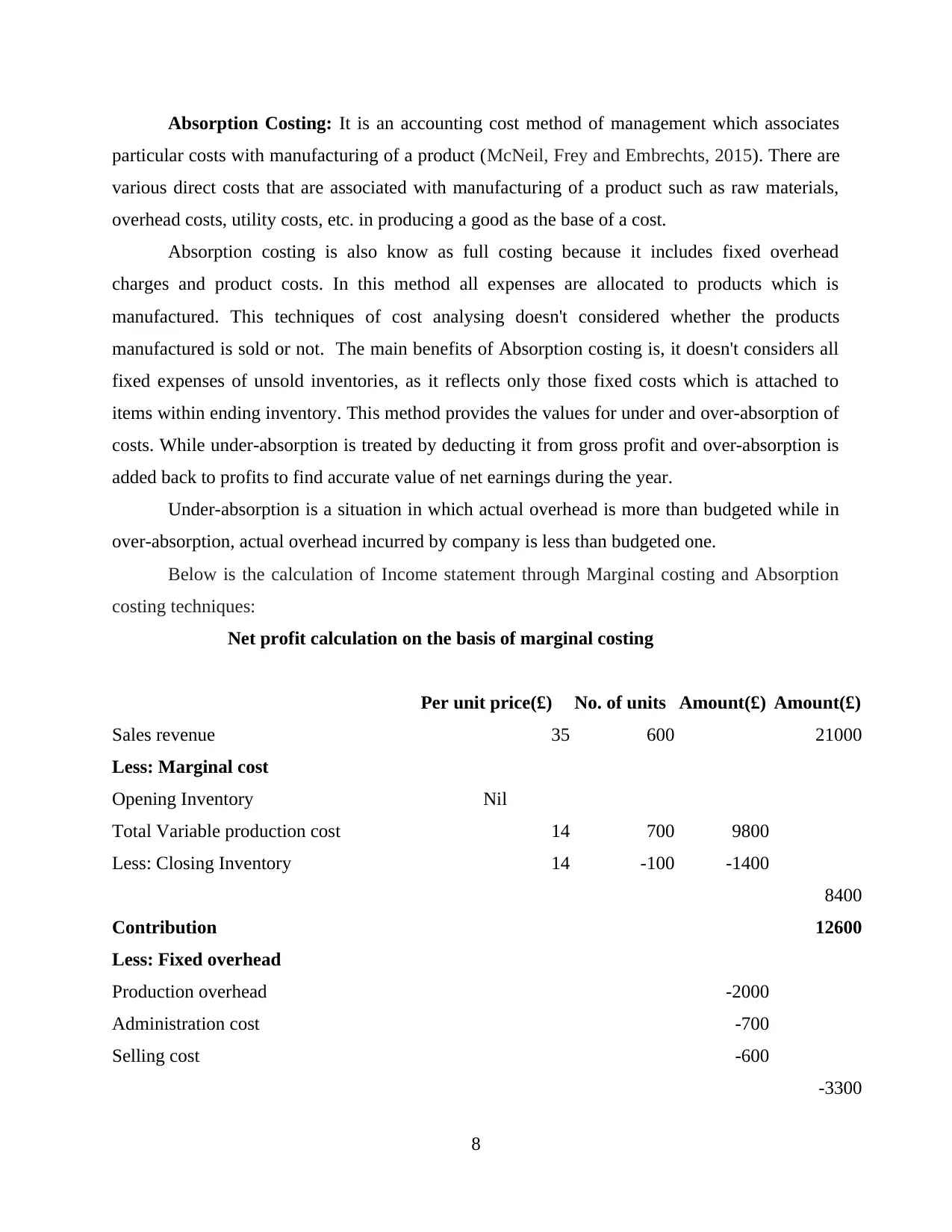
Absorption Costing: It is an accounting cost method of management which associates
particular costs with manufacturing of a product (McNeil, Frey and Embrechts, 2015). There are
various direct costs that are associated with manufacturing of a product such as raw materials,
overhead costs, utility costs, etc. in producing a good as the base of a cost.
Absorption costing is also know as full costing because it includes fixed overhead
charges and product costs. In this method all expenses are allocated to products which is
manufactured. This techniques of cost analysing doesn't considered whether the products
manufactured is sold or not. The main benefits of Absorption costing is, it doesn't considers all
fixed expenses of unsold inventories, as it reflects only those fixed costs which is attached to
items within ending inventory. This method provides the values for under and over-absorption of
costs. While under-absorption is treated by deducting it from gross profit and over-absorption is
added back to profits to find accurate value of net earnings during the year.
Under-absorption is a situation in which actual overhead is more than budgeted while in
over-absorption, actual overhead incurred by company is less than budgeted one.
Below is the calculation of Income statement through Marginal costing and Absorption
costing techniques:
Net profit calculation on the basis of marginal costing
Per unit price(£) No. of units Amount(£) Amount(£)
Sales revenue 35 600 21000
Less: Marginal cost
Opening Inventory Nil
Total Variable production cost 14 700 9800
Less: Closing Inventory 14 -100 -1400
8400
Contribution 12600
Less: Fixed overhead
Production overhead -2000
Administration cost -700
Selling cost -600
-3300
8
particular costs with manufacturing of a product (McNeil, Frey and Embrechts, 2015). There are
various direct costs that are associated with manufacturing of a product such as raw materials,
overhead costs, utility costs, etc. in producing a good as the base of a cost.
Absorption costing is also know as full costing because it includes fixed overhead
charges and product costs. In this method all expenses are allocated to products which is
manufactured. This techniques of cost analysing doesn't considered whether the products
manufactured is sold or not. The main benefits of Absorption costing is, it doesn't considers all
fixed expenses of unsold inventories, as it reflects only those fixed costs which is attached to
items within ending inventory. This method provides the values for under and over-absorption of
costs. While under-absorption is treated by deducting it from gross profit and over-absorption is
added back to profits to find accurate value of net earnings during the year.
Under-absorption is a situation in which actual overhead is more than budgeted while in
over-absorption, actual overhead incurred by company is less than budgeted one.
Below is the calculation of Income statement through Marginal costing and Absorption
costing techniques:
Net profit calculation on the basis of marginal costing
Per unit price(£) No. of units Amount(£) Amount(£)
Sales revenue 35 600 21000
Less: Marginal cost
Opening Inventory Nil
Total Variable production cost 14 700 9800
Less: Closing Inventory 14 -100 -1400
8400
Contribution 12600
Less: Fixed overhead
Production overhead -2000
Administration cost -700
Selling cost -600
-3300
8
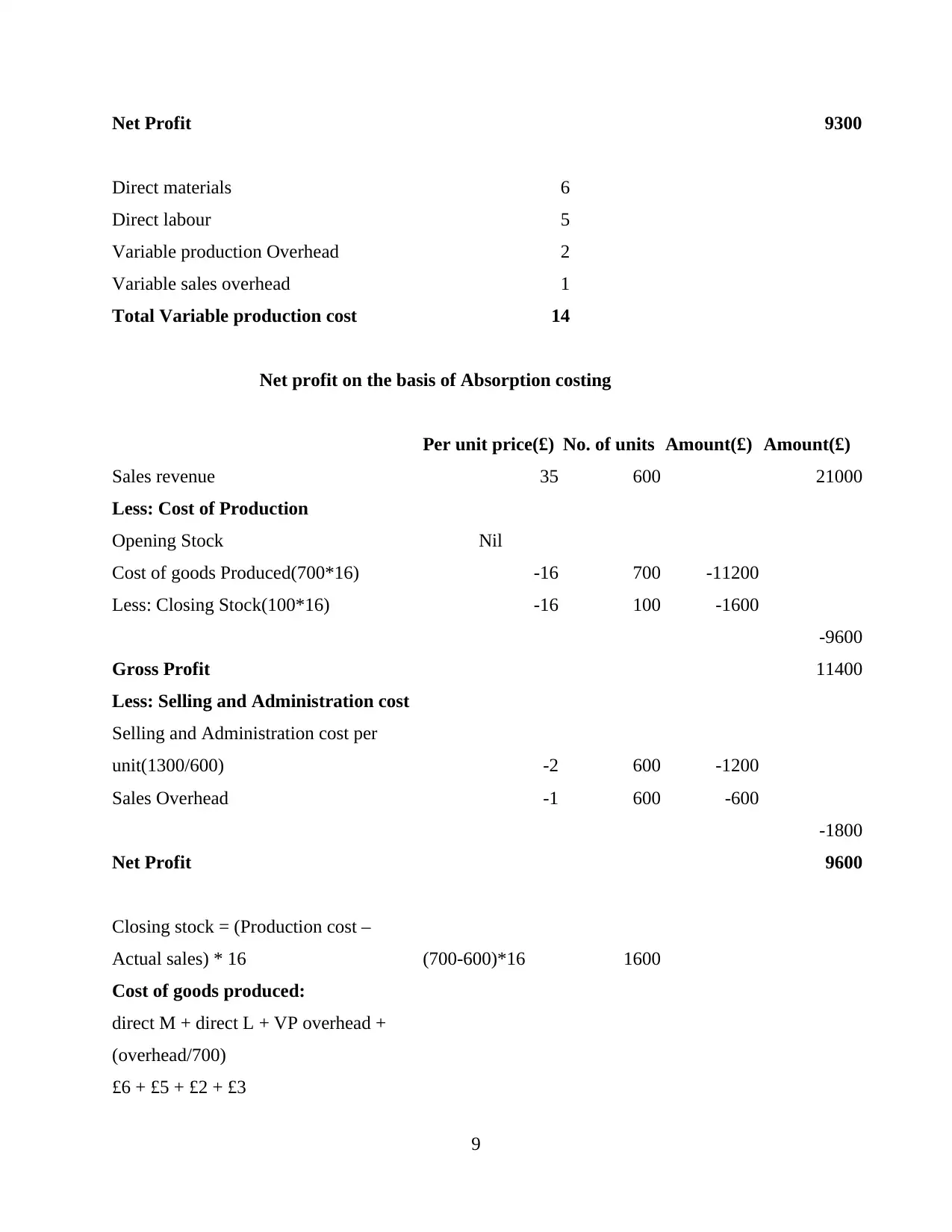
Net Profit 9300
Direct materials 6
Direct labour 5
Variable production Overhead 2
Variable sales overhead 1
Total Variable production cost 14
Net profit on the basis of Absorption costing
Per unit price(£) No. of units Amount(£) Amount(£)
Sales revenue 35 600 21000
Less: Cost of Production
Opening Stock Nil
Cost of goods Produced(700*16) -16 700 -11200
Less: Closing Stock(100*16) -16 100 -1600
-9600
Gross Profit 11400
Less: Selling and Administration cost
Selling and Administration cost per
unit(1300/600) -2 600 -1200
Sales Overhead -1 600 -600
-1800
Net Profit 9600
Closing stock = (Production cost –
Actual sales) * 16 (700-600)*16 1600
Cost of goods produced:
direct M + direct L + VP overhead +
(overhead/700)
£6 + £5 + £2 + £3
9
Direct materials 6
Direct labour 5
Variable production Overhead 2
Variable sales overhead 1
Total Variable production cost 14
Net profit on the basis of Absorption costing
Per unit price(£) No. of units Amount(£) Amount(£)
Sales revenue 35 600 21000
Less: Cost of Production
Opening Stock Nil
Cost of goods Produced(700*16) -16 700 -11200
Less: Closing Stock(100*16) -16 100 -1600
-9600
Gross Profit 11400
Less: Selling and Administration cost
Selling and Administration cost per
unit(1300/600) -2 600 -1200
Sales Overhead -1 600 -600
-1800
Net Profit 9600
Closing stock = (Production cost –
Actual sales) * 16 (700-600)*16 1600
Cost of goods produced:
direct M + direct L + VP overhead +
(overhead/700)
£6 + £5 + £2 + £3
9
⊘ This is a preview!⊘
Do you want full access?
Subscribe today to unlock all pages.

Trusted by 1+ million students worldwide
1 out of 20
Related Documents
Your All-in-One AI-Powered Toolkit for Academic Success.
+13062052269
info@desklib.com
Available 24*7 on WhatsApp / Email
![[object Object]](/_next/static/media/star-bottom.7253800d.svg)
Unlock your academic potential
Copyright © 2020–2025 A2Z Services. All Rights Reserved. Developed and managed by ZUCOL.





